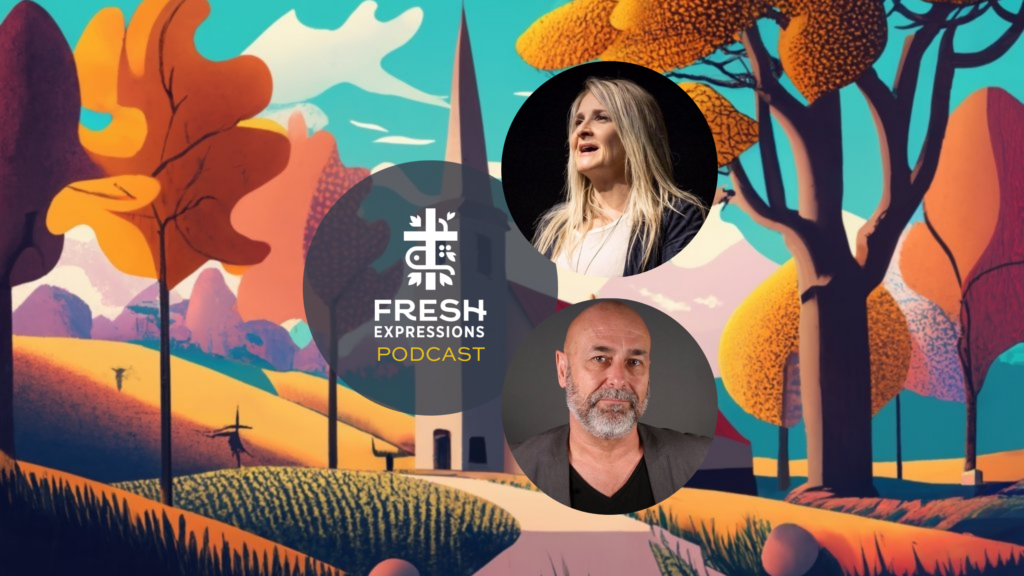Listen
Watch
Show Notes
Friend and missional mentor Michael Frost returns to the Fresh Expressions podcast to discuss his book Mission Is the Shape of Water: Learning From the Past to Inform Our Role in the World Today.
Does mission look the same across all times and places? Michael Frost says “no!” in his latest book. He dives into Christian mission through the centuries, examining how context sculpts mission uniquely in each era.
We’ll explore the shaping forces of history, culture, and postmodernism on the Church’s mission and hear stories of innovative, situation-specific efforts from across the centuries. Examining mission in light of history is critical for discerning mission now. This conversation will lead you to follow God into a uniquely “shape” mission for your context.
Fresh Expressions is a worldwide movement of everyday missionaries who want to see churches thrive in the places we live, eat, work and play by leveraging the creativity and endurance of the inherited church. To learn a simple five-phase process for starting a new expression of church go to freshexpressions.com/howtostart.
If you love this free resource, you can access our entire library of practical and inspiring training materials and connect with other church leaders on FX Connect. Sign up for your free account at fxconnectus.org.
Help us spread the word about the Fresh Expressions podcast by subscribing and leaving us reviews on Apple Podcasts, Spotify, YouTube or wherever you enjoy your podcasts.
Interview Summary
In “Mission is the Shape of Water,” Michael Frost challenges the church to draw from its rich history to redefine its mission. He emphasizes, “When you look at the sweep of history… it broadens our imaginations… and frees us from a pretty narrow band of innovation.” Frost’s approach is not about reverting to the past but using it to expand our understanding and application of mission today.
Stories of Contextualized Mission
Frost shares compelling stories like that of Alice Seeley Harris, a missionary who intended to translate the Bible in the Congo but found herself documenting human rights atrocities instead. “She goes with one shape in mind… but the context throws up to her a human rights tragedy… reshaping her mission to become a human rights advocate.”
Similarly, he narrates the story of Tony Rinaudo, an Australian missionary in Western Africa. Originally focused on traditional missionary work, he shifted to environmental restoration when he saw the deforestation crisis. “He has effectively reforested… the nir Delta by teaching Africans… to grow trees from the roots underground.”
The Vital Role of Cultural Contextualization
Frost distinguishes between cultural adaptation and contextualization, stressing the need for the latter in mission. He points out the importance of understanding the unique characteristics of each community to foster a genuinely contextualized mission. “Cultural contextualization is where we ask ourselves in what way does the church actually take root in the soil in which it’s been planted.”
A Balanced View of Missionary History
In discussing the legacy of missionaries, Frost acknowledges both their contributions and the darker aspects of their history. He notes the evolution of missionary orders like the Jesuits, initially filled with zeal and vision, but later involved in harmful practices under the guise of mission.
Humility and Grassroots Movements in Today’s Mission
Frost advocates for humility and grassroots movements in modern missions, especially in a post-Christian context. He believes the church’s future lies in embracing more inclusive, community-based forms of worship and service. “We have to recover this idea of humbly recognizing our more marginal status… and start to demonstrate what it looks like to be a grassroots movement.”
Navigating the Waters of Mission with Wisdom from the Past
“Mission is the Shape of Water” by Michael Frost provides a profound exploration of how the history of Christian missions can inform and enrich our approach to ministry in the present day. Frost’s insights encourage a deeper understanding of how the church’s mission has evolved and the importance of contextualizing this mission to meet the unique needs of each community.
Key Takeaways:
- Historical Perspective: Understanding the broad history of Christian missions can expand our imagination and approach to mission. As Frost states, “It broadens our imaginations… and frees us from a pretty narrow band of innovation.”
- Contextualized Mission: The stories of Alice Seeley Harris and Tony Rinaudo exemplify how missions can be reshaped by the context, evolving from traditional approaches to addressing specific, urgent needs within the community.
- Cultural Contextualization vs. Adaptation: Distinguishing between cultural adaptation and deep contextualization is crucial. The church must strive to root itself authentically within the cultural soil of its community.
- Balanced Historical View: Recognizing both the positive contributions and the harmful practices of historical missionaries helps us to approach mission work with humility and a balanced perspective.
- Grassroots Movements: In a post-Christian context, the church is called to embrace humility and focus on grassroots movements of love, justice, and compassion, moving away from hierarchical structures.
- The Future of Church Mission: The book encourages churches to innovate within their context, reflecting Frost’s vision: “I would love to see… a whole bunch of new fresh expressions of what the church might look like.”
Reflective Questions for Church Leaders
- How can the story of Alice Seeley Harris inspire us to respond to unanticipated needs in our community?
- In what ways can Tony Rinaudo’s approach to environmental restoration inform our mission strategy in areas facing ecological crises?
- How can we differentiate between cultural adaptation and deep contextualization in our church practices?
- In what ways can we involve our congregation in understanding and serving the unique cultural context of our community?
- How can we use technology and modern communication methods effectively in our mission work, as exemplified by Alice Seeley Harris’s use of photography?

